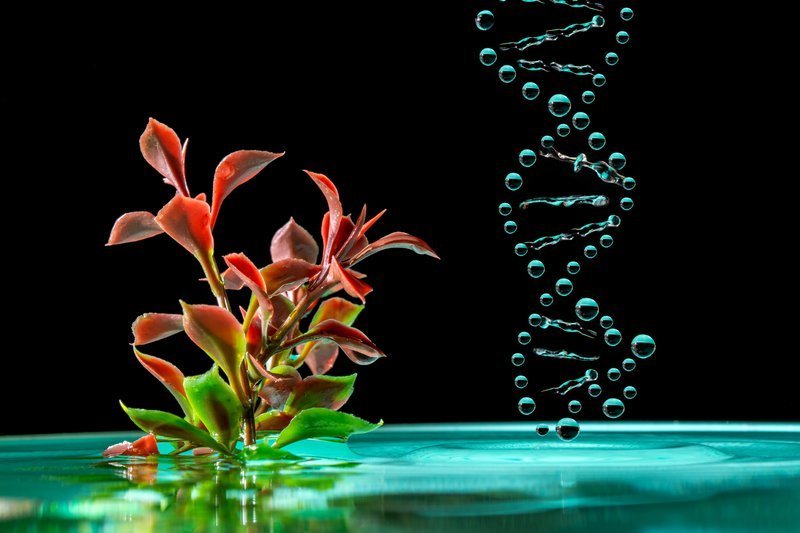
Are you concerned about Genetically Modified Foods? Here’s (GMOs Revealed) a great documentary that addresses many of the questions and concerns most people have today.
In March 2014, scientists from Indiana Universityannounced that they had conducted research to examine the operations of the fruit fly genome “in greater detail than ever before possible” and had identified “thousands of new genes, transcripts and proteins.” Their results indicated that the fly’s genome is “far more complex than previously suspected and suggests that the same will be true of the genomes of other higher organisms.” Of the approximately 1,500 new genes that were discovered, 536 of them were found within areas that were previously assumed to be gene-free zones. Furthermore, when the flies were subjected to stresses, small changes in expression level at thousands of genes occurred, and four newly modelled genes were expressed altogether differently.
Why is this important? Because it reveals how little we know about this planet and the organisms dwelling on it, yet also how much we think we know. This kind of hubris is found within all areas of human knowledge, but particularly when it comes to science.
Another great example that I’ve used before is when the populace first realized that the Earth wasn’t flat. Another is a statement made by physicist Lord Kelvin, who stated in 1900 that “there is nothing new to be discovered in physics now. All that remains is more and more precise measurement.” This assertion was shattered only five years later when Einstein published his paper on special relativity.
When it comes to our genes, and the genes of other organisms, we really do know next to nothing. Unfortunately, proponents of the biotech industry (Monsanto, DuPont, Syngenta, etc.) claim otherwise, and have developed multiple, flawed assumptions that undergird agricultural bioengineering.
The information presented in this article comes from a variety of different sources, but my primary sourceis Steven Druker, a public interest attorney and the Executive Director of the Alliance for Bio-Integrity. He initiated a lawsuit in 1998 that forced the U.S. Food and Drug (FDA) to release its files on genetically engineered foods, and recently published a book about it, which has received dozens of rave reviews from the world’s most accredited scientists in the field. I draw primarily from his book for this article.
“This incisive and insightful book is truly outstanding. Not only is it well reasoned and scientifically solid, it’s a pleasure to read – and a must-read. Through its masterful marshalling of facts, it dispels the cloud of disinformation that has misled people into believing that GE foods have been adequately tested and don’t entail abnormal risk.” – David Schubert, PhD, molecular biologist and Head of Cellular Neurobiology, Salk Institute for Biological Studies.
Natural Genetic Modification Versus Human Induced Genetic Modification
Biotech proponents have an unshakable faith in their GE crops, and these corporations also hold major sway over mainstream media outlets, and close relationships with government agencies like the FDA. Indeed, several high level industry employees have also held positions at these institutions. One example is the FDA Deputy Commissioner for Foods, Michael Taylor, who is also Monsanto’s former Vice President for Public Policy. While at the FDA, he was instrumental in getting approval for Monsanto’s genetically engineered bovine growth hormone.
Druker outlines in his book how the commercialization of genetically engineered foods was enabled by the fraudulent behaviour of these government agencies, and how this actually violates explicit mandates for federal food safety law. The evidence shows that the “FDA’s falsehoods have been abundantly supplemented with falsehoods disseminated by eminent scientists and scientific institutions, and the entire GE food venture.”
This is why it’s so amazing to see so many scientists within the field supporting the dissemination of truth, and bringing the falsehoods to light. So if you still think this type of thing is a conspiracy theory, we now have the documents as well as the science, which stands on its own, to show that something is terribly wrong here.
Joseph Cummins, Ph.D. and Professor Emeritus of Genetics at Western University in London, Ontario, believes that Druker’s book is a “landmark” and that “it should be required reading in every university biology course.”
There are several presumptions on which the bioengineering venture was based, and one of them is that natural breeding is more random and unruly than bioengineering. The standard argument holds that genetic modification has been occurring for thousands of years, and what we do now is simply that process sped up and made better.

Key Presumptions on Which the Bioengineering Venture Was Based
Genetic engineering is based on the presumption that the genome is just a linear system, where the action of a single gene will not impact the action of other genes, or disrupt their normal function.
In 2007, the New York Times published an article outlining how “the presumption that genes operate independently has been institutionalized since 1976, when the first biotech company was founded. In fact, it is the economic and regulatory foundation on which the entire biotechnology industry is built.”
Basically, genes are viewed as autonomous, adding to the whole without acting holistically because they don’t express their proteins in a closely coordinated matter. Another assumption used to justify genetic engineering is that genes aren’t organized in a specific way, that the sequence in which they occur is meaningless From this point of view, a gene would function normally if it were relocated to a different chromosome or came from a neighbouring gene. Quite a big assumption, don’t you think? Giorgio Bernardi, a biologist at the University of Rome III who specialized in the study of genome evolution, calls this perspective a “bean-bag view of the genome” because it regards the genes as “randomly distributed.”
Druker explains:
Together, these two assumptions supported the belief that a chunk of recombinant DNA could be put into a plan’s genome without inducing disturbance — because if the behavior of the native genes was largely uncoordinated and their arrangement was irrelevant, there would be no important patterns that could be perturbed by such insertions. Accordingly, they engendered confidence in the precision of genetic engineering, because they implied that the outcome of a gene insertion would be exactly what the bioengineers expected.
How could biotech proponents push the idea that the target organism would continue to function just as it had before, and that the change would be limited to the new trait endowed by the inserted gene? How can it simply be assumed that this would not alter any of the organism’s other qualities?
These presumptions still underly genetic engineering today. The example of the fly above serves well here. In the New York Times article cited earlier, the author noted that “genes appear to operate in a complex network,” and states that “evidence of a networked genome shatters the scientific basis for virtually every official risk assessment of today’s commercial biotech products, from genetically engineered crops to pharmaceuticals.”
Molecular geneticist Michael Antoniou, who testified at New Zealand’s Royal Commission in 2001, notes that agricultural bioengineering “was based on the understanding of genetics we had 15 years ago, about genes being isolated little units that work independently of each other.” He also presented evidence showing that genes actually “work as an integrated whole of families.”
Despite the grave possibility that these presumptions are indeed wrong, they still form the backbone of genetic engineering today.
Antoniou himself was even selected to represent multiple nongovernmental organizations to present precaution reasons to the UK’s GM Review Panel, and a plethora of studies that clearly justify it. Despite his presentation, and many others’, the 11 other scientists on the panel, who were biotech proponents, dismissed these studies and continued to argue that it makes absolutely no difference how genes are arranged.
How can a scientist make such a statement?
What do we have as a result? As Druker says:
Such disregard, denial, or avoidance in regard to the evidence was essential for maintaining faith in the venture, because its predictability and safety have always relied on the genome being largely disjointed; and the more the genome instead appears to function as a tightly coordinated system, the more potentially disruptive and unpredictable are the interventions of the bioengineers.
Geneticist, activist, and environmentalist David Suzuki weighed in on this very subject a few years ago in an interview with the Canadian Broadcasting Corporation (CBC):
By slipping it into our food without our knowledge, without any indication that there are genetically modified organisms in our food, we are now unwittingly part of a massive experiment. . . . Essentially, the FDA has said that genetically modified organisms, or food, are basically not much different from regular food, and so they’ll be treated in the same way. The problem is this: Geneticists follow the inheritance of genes, in what we call a vertical fashion . . . [but] what biotechnology allows us to do is to take this organism, and move it, what we call horizontally, into a totally unrelated species. Now, David Suzuki doesn’t normally mate with a carrot plant and exchange genes. What biotechnology allows us to do is to switch genes from one to the other, without regard for the biological constraints. . . . It’s very very bad science. We assume that the principals governing the inheritance of genes vertically applies when you move genes laterally or horizontally. There’s absolutely no reason to make that conclusion.
More Differences
This is a common argument made by GE-food proponents, and commonly used whenever an expert brings up a challenge to the technology’s safety. For example, David Schubert, PhD, a molecular biologist
and the Head of Cellular Neurobiology at the Salk Institute for Biological Studies, commented in Nature Biotechnology that there was mounting evidence that the insertion of even one gene into a cell’s DNA alters the expression patters of genes throughout the entire cell. He said facts like this one, among many others, “cast doubt on the soundness of agricultural bioengineering — and entail the conclusion that it ‘is not a safe option.’ “

Predictably, when a professor and a laboratory director of one of the world’s most prestigious scientific institutions makes a comment like this, there’s going to be a response. This time it came in the form of a letter, published by 18 biologists at respected universities and institutions, stating that Dr. Schubert failed to properly consider “the genetic realities.” The main reality he allegedly failed to recognize is that the natural method of plant breeding is inherently more random than bioengineering.
A portion of the letter reads as following:
We do not take issue with Schubert’s basic contention that unintended genetic and metabolic events can take place. The reality is that ‘unintentional consequences’ are much more likely to occur in nature than in biotechnology because nature relies on the unintentional consequences of blind random genetic mutation and rearrangement to produce adaptive phenotypic results, whereas GM technology employs precise, specific, and rationally designed genetic modification toward a specific engineering goal.
In his book, Steven Druker offers the following counterargument: “This letter thus reveals how strongly the GE food venture relies on the presumption that the natural process driving biological development are intrinsically more disorderly and risk-bearing than the genetic interventions instigated by the human mind. And it confirms that this belief forms the ideological bedrock on which the venture rests.”
In fact, a report published in 2004 by the National Academy of Sciences couldn’t uphold “even the more modest notion that bioengineering and natural breeding pose the same risks.” The panel that produced the report ranked various modes of plant breeding in terms of their disposition to produce unintended effects. They were forced to acknowledge that bioengineering produces far greater effects than pollen-based sexual reproduction. Despite this fact, they still insisted that this does not mean a difference in risks.
Druker says in response:
Thus, there’s no rational way to reconcile the fact that natural breeding is less disruptive and more predictable than bioengineering with the claim that it poses equal or greater risk, which is why the admission in the 2004 report is a rarity — and why biotech proponents almost always ignore or deny that fact and instead assert that natural breeding is more disorderly and unpredictable.
Randomness
According to the biotech industry, natural plant breeding could actually result in crops that are dangerous to human consumption, which is why we should be grateful for genetic engineering. For example, in the same NAS report mentioned above, they portrayed what are known as “jumping genes” as more randomly mobile and threatening, but failed to recognize, as Druker points out, that although these entities do not pose risks within natural pollen based breeding, when bioengineering is employed they do because that process alone “tends to stir them up and get them jumping.”
When it comes to sexual reproduction, it’s yet another area where biotech proponents state that it’s a random phenomenon, despite the fact that we now know that it’s not random, and that there are multiple factors that can and do influence the genetics of life. Genetic engineering, be it human induced or naturally occurring, requires a genetic “rearragnement,” a recombination of DNA. The difference between the artificial way and the natural way is that the natural way does not disrupt the entire organism, as was discussed a little earlier in the article and touched upon in the Suzuki quote above.
As Druker explains:
This natural form of recombination occurs during the formation of gametes (the sperm and egg cells). It includes a step called crossover in which two partner chromosomes break at corresponding points and then exchange complementary sections of DNA; and every time a gamete is produced, every set of paired chromosomes engages in it. In this way, all the chromosomes end up with genes from both parents instead of from only one. However, all the genes are preserved, as is the sequences in which they’re positioned. The only changes are in the relationships between aleles. . . . So this natural recombination augments diversity while maintaining stability. And without it, except for the occasional favorable mutation, the composition of chromosomes would stay the same from generation to generation, and genetic diversity would grow at far too sluggish a pace.

He goes on to mention how natural recombination preserves the order of the genes, and is predictable in the way it cuts DNA. The entire process displays a great deal of order.
Despite this fact, scientists who support GE state, as in, for example, the 2004 NAS report, that “genetic engineering methods are considered by some to be more precise than conventional breeding methods because only known and precisely characterized genes are transferred.” They use the idea that the randomness and unpredictability of natural engineering make bioengineering safer.
Yet, as Druker so brilliantly captures:
This misleading tactic fixates on the predictability of the plant’s specific agronomic traits; and it portrays traditional breeding as less predictable than bioengineering because undesired attributes are often transferred along with the one that is desired. However, those who employ this ploy don’t acknowledge that if both parents are safe to eat, the unwanted traits hardly ever pose risk to human health. Rather, they’re undesirable for reasons irrelevant to risk (such as aesthetic appearance or seed size), and breeders must then perform back-crossing to eliminate them while retaining the trait they want. However, although the inclusion of unwanted traits entails more work, it does not increase attendant risks. Therefore, while breeders can’t fully predict what traits will appear, they can confidently predict that the resulting plant will be safe to eat.
This is why the GE stance on natural modification is so flawed and misleading.
Druker goes on:
Although it describes the sexual reproduction of food-yielding plants as a messy and risky affair that involves the transfer of “thousands of unknown genes with unknown function,” we actually know quite a lot about those genes. And what we know is far more important than what we don’t know. We know that they’re all where they’re supposed to be, and that they’re arranged in an orderly fashion. And we know that during the essential process in which some of them are traded between partnered chromosomes in order to promote the diversity that strengthens the species, their orderly arrangement is marvelously maintained. Most important, we know that their functions mesh to form an exquisitely efficient system that generates and sustains a plant that regularly provides us with wholesome food.
This sharply contrasts with genetic engineering.
As you can see, comparing natural modification to biotech modification is not an easy process, and this isn’t even the tip of the iceberg. Research shows that it’s not natural modification that’s more random and risky, but biotech genetic modification:
The inserted cassettes are haphazardly wedged into the cell’s DNA, they create unpredictable disruptions at the site of insertion, the overall process induces hundreds of mutations throughout the DNA molecule, the activity of the inserted cassettes can create multiple imbalances, and the resultant plant cannot be deemed safe without undergoing a battery of rigorous tests that has yet to be applied to any engineered crop.
Disclaimer: We at Prepare for Change (PFC) bring you information that is not offered by the mainstream news, and therefore may seem controversial. The opinions, views, statements, and/or information we present are not necessarily promoted, endorsed, espoused, or agreed to by Prepare for Change, its leadership Council, members, those who work with PFC, or those who read its content. However, they are hopefully provocative. Please use discernment! Use logical thinking, your own intuition and your own connection with Source, Spirit and Natural Laws to help you determine what is true and what is not. By sharing information and seeding dialogue, it is our goal to raise consciousness and awareness of higher truths to free us from enslavement of the matrix in this material realm.
 EN
EN FR
FR


























Nature provides everything, in a magnificent balance, in chaos and harmony both. Nature is my best teacher and the most patient one, for nature and I are both of the same making…. making waves 😉
Here’s a document about the function and value of cow’s horns:
https://files.acrobat.com/a/preview/49818cc8-6b95-4547-8362-e804f54bcfb9
Without going through much scientific research and evidence of damaging or so called profitable devedlopment in agriculture, regarding GMO practice, as soon as I heard about it, my gut-feeling yelled a loud “No!” The following is where every fibre of my being yells a loud “Yes!”:
(quote)The origins of the biodynamic movement.
The biodynamic movement grew out of the deep concerns of a group of farmers in central Europe back in the 1920’s. They had noticed an increasing degeneration in seed strains, in many cultivated plants and in their livestock. They approached scientist and philosopher Rudolf Steiner in 1924 seeking some insights and practical ideas to offset this decline. (How much has happened to exacerbate this trend since then!)
Steiner envisaged what might happen if mineral fertilizers should be used extensively in farming, rather than the natural fertility of animal manures and good compost. He said:
“The materialistic farmer who thinks about these matters can calculate how many decades it will be in this century before agricultural products have degenerated so far that they can no longer nourish the human being adequately. With the materialistic world conception, agriculture has come the furthest away from rational principles” (Agriculture)
For more on that subject: http://wn.rsarchive.org/Lectures/GA327/English/BDA1958/19240607p01.html
He went on to predict how farm products would become so de-natured that people would endeavour to make mineral blueprints of them, and here we are reminded of the growth of the mineral and vitamin supplement industry over past decades. Steiner pointed out that not only was the earth already middle-aged, but it would become increasingly sclerotic (declining in vitality) as a result of the developing materialistic view of the earth as a resource for human beings to exploit. When he was persuaded to offer his insights into agriculture, his aim was to try and correct a largely one-sided, mechanistic view of nature, entrenched as early as the 1920’s. Steiner’s approach offered a view of life that reconnected the earth and the cosmos, physical life with its origins, in a spiritual world-view – a vision that takes account of the powerful forces that pour down from the cosmos, to work within the soil and the plant.
These forces stimulate the processes vital to agriculture, but in order for these beneficient influences to be fully active, the soil needs to be sufficiently sensitive. This in turn requires the use of natural organic fertilizing materials, to keep it alive. Coupled with this, special potentized “medicines” (usually known as “preparations”) would be required for the compost heap and for spraying on the land, as well as a renewed understanding of planetary and zodiacal influences, to be creatively harnessed by the sensitive farmer”.(end of quote
Excerpt from the brochure “What is Biodynamic Farming?” written by Wendy E.Cook. Republished by the Biodynamic Association. www.biodynamic.org.uk
An example of farmer’s wisdom in quips:
“Kräht der Hahn auf dem Mist,
So regnet es, oder es bleibt wie es ist.”
“If the cock crows on the dunghill,
It’ll rain — or it’ll stay still.”
And to end this long comment, here’s what Rudolf Steiner said, on June 11th 1924, at the end of the lecture in this link: http://wn.rsarchive.org/Lectures/GA327/English/BDA1958/Ag1958_address.html
“Therefore, I beg you to regard me as the small peasant farmer who has conceived a real love for farming; one who remembers his small peasant farm and who thereby, perhaps, can understand what lives in the peasantry, in the farmers and yeomen of our agricultural life. They will be well understood at Dornach; of that you may rest assured. For I have always had the opinion (this was not meant ironically, though it seems to have been misunderstood) that their alleged stupidity or foolishness is “wisdom before God,” that is to say, before the Spirit. I have always considered what the peasants and farmers thought about their things far wiser than what the scientists were thinking. I have invariably found it wiser, and I do so to-day. Far rather would I listen to what is said of his own experiences in a chance conversation, by one who works directly on the soil, than to all the Ahrimanic statistics that issue from our learned science”.
I first heard of GMOs a little after 2003 and it quickly became the green movement. Soon after everyone was “going green” and like always, a system of mass deception onslaught by our Government was implemented as they mass produced all these products and food containing genetically altered material, in our foods, and other consumable products deemed safe by the FDA.
Yet still, so many were deceive, when this first began. Now it is coming full circle, in that – the actions of those individuals in power who abuse their power and oppress the very same people they were sworn in to sever as public servants to the people not oppressors of a people.
Only amended legislation can change this, only by passing laws that will fix this or make it go away,
would-be a first step in reversing the damage already made by GMOs. We as a people can peacefully protest and speak out on this but ultimately laws must be passed in order for this madness to end, I say ‘let us grow our food,’ it worked in the passed in this land we call America it can work again. End to all gmos!
Thanks you for this informed documentation